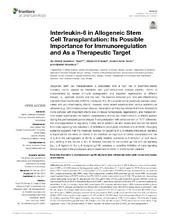| dc.contributor.author | Tvedt, Tor Henrik Anderson | en_US |
| dc.contributor.author | Ersvær, Elisabeth | en_US |
| dc.contributor.author | Tveita, Anders | en_US |
| dc.contributor.author | Bruserud, Øystein | en_US |
| dc.date.accessioned | 2017-11-06T13:38:26Z | |
| dc.date.available | 2017-11-06T13:38:26Z | |
| dc.date.issued | 2017-06-08 | |
| dc.Published | Tvedt THA, Ersvær E, Tveita AA, Bruserud Ø. Interleukin-6 in allogeneic stem cell transplantation: Its possible importance for immunoregulation and as a therapeutic target. Frontiers in Immunology. 2017;8:667 | eng |
| dc.identifier.issn | 1664-3224 | |
| dc.identifier.uri | https://hdl.handle.net/1956/16850 | |
| dc.description.abstract | Allogeneic stem cell transplantation is associated with a high risk of treatment-related mortality mainly caused by infections and graft-versus-host disease (GVHD). GVHD is characterized by severe immune dysregulation and impaired regeneration of different tissues, i.e., epithelial barriers and the liver. The balance between pro- and anti-inflammatory cytokine influences the risk of GVHD. Interleukin-6 (IL-6) is a cytokine that previously has been associated with pro-inflammatory effects. However, more recent evidence from various autoimmune diseases (e.g., inflammatory bowel disease, rheumatoid arthritis) has shown that the IL-6 activity is more complex with important effects also on tissue homeostasis, regeneration, and metabolism. This review summarizes the current understanding of how pro-inflammatory IL-6 effects exerted during the peritransplant period shapes T-cell polarization with enhancement of Th17 differentiation and suppression of regulatory T cells, and in addition we also review and discuss the results from trials exploring non-selective IL-6 inhibition in prophylaxis and treatment of GVHD. Emerging evidence suggests that the molecular strategy for targeting of IL-6-initiated intracellular signaling is important for the effect on GVHD. It will therefore be important to further characterize the role of IL-6 in the pathogenesis of GVHD to clarify whether combined IL-6 inhibition of both trans- (i.e., binding of the soluble IL-6/IL-6 receptor complex to cell surface gp130) and cis-signaling (i.e., IL-6 ligation of the IL-6 receptor/gp130 complex) or selective inhibition of trans-signaling should be tried in the prophylaxis and/or treatment of GVHD in allotransplant patients. | en_US |
| dc.language.iso | eng | eng |
| dc.publisher | Frontiers | eng |
| dc.rights | Attribution CC BY | eng |
| dc.rights.uri | http://creativecommons.org/licenses/by/4.0 | eng |
| dc.subject | interleukin-6 | eng |
| dc.subject | cytokine receptor gp130 | eng |
| dc.subject | allogeneic stem cell transplantation | eng |
| dc.subject | graft-versus-host disease | eng |
| dc.subject | Janus kinases | eng |
| dc.title | Interleukin-6 in allogeneic stem cell transplantation: Its possible importance for immunoregulation and as a therapeutic target | en_US |
| dc.type | Peer reviewed | |
| dc.type | Journal article | |
| dc.date.updated | 2017-10-06T09:03:59Z | |
| dc.description.version | publishedVersion | en_US |
| dc.rights.holder | Copyright 2017 The Author(s) | |
| dc.identifier.doi | https://doi.org/10.3389/fimmu.2017.00667 | |
| dc.identifier.cristin | 1484307 | |
| dc.source.journal | Frontiers in Immunology | |

